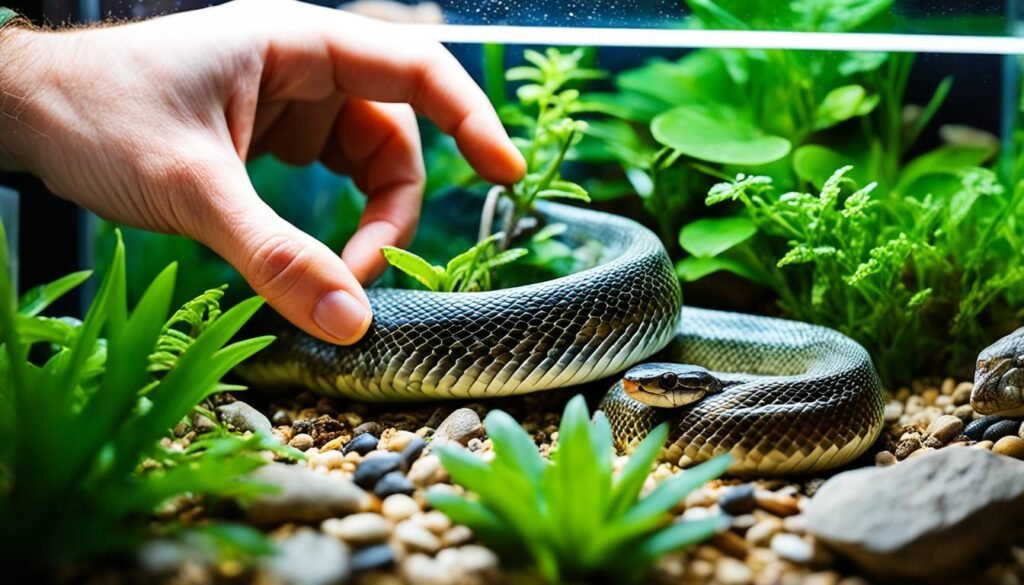Many potential snake owners look for pets that don’t need frozen mice or rats. Why pet snakes that don’t eat mice? This might be because they don’t like feeding them, or they have other pet rodents. The search for snakes with different diets is clear. It shows there is a market for snakes that can be healthy without eating mice or rats.
There are snake species for those who don’t want to feed them rodents. Knowing about these other diets lets snake owners choose according to their values. This way, they can enjoy keeping a snake that doesn’t eat mice or rats.
Introduction to Pet Snakes with Alternative Diets
Many snake lovers are now choosing non-rodent eaters as their pets. This choice is great for those who don’t want the challenge of dealing with mice. It could be because they care about animal welfare or simply like variety. Snakes that don’t eat mice open up new options in the pet snake world.
The Growing Trend of Non-Rodent Eating Snakes
Non-rodent eating snakes are becoming more popular. They are easy to care for and offer different feeding options. This option is especially good for those who don’t like handling dead animals. This trend shows how snake owners are finding new ways to meet their pets’ and their own needs.
Benefits of Owning Snakes with Specialized Diets
There are many good things about having a snake that eats non-rodent food. They make feeding your pet much simpler. Plus, you can choose from various meals that might be more in line with your beliefs. Snakes that eat non-mice have a lot to offer, making them an interesting choice for new snake owners.
Species of Pet Snakes That Don’t Need to Eat Rodents
Some snake kinds don’t eat rodents at all. They do well with other types of food. For example, the African Egg-Eating Snake, Rough Green Snake, and Garter and Ribbon Snakes. These types have special ways of eating that don’t require rodents.
African Egg-Eating Snake
Meet the African Egg-Eating Snake. This snake only eats eggs, as you might guess from its name. It doesn’t need to eat rodents. It can swallow eggs whole thanks to its special jaws. So, it’s a great choice for owners who want a snake that doesn’t eat mammals.
Rough Green Snake
The Rough Green Snake is another interesting type. It mostly eats insects and small creatures without a backbone. With its bright green color, it’s not just pretty but also easy to feed. Owners can find plenty of insects like crickets for them to munch on.
Garter and Ribbon Snakes
If you’re looking for a snake that skips eating rodents, consider Garter and Ribbon Snakes. They eat small fish, amphibians, and earthworms. These snakes are flexible in what they can eat. That makes caring for them simpler. They enjoy a mix of foods that are easy to provide in captivity.
| Snake Species | Primary Diet | Preferred Environment |
|---|---|---|
| African Egg-Eating Snake | Eggs | Arid and semi-arid regions |
| Rough Green Snake | Insects | Forests and grasslands |
| Garter and Ribbon Snakes | Small fish and amphibians | Wet meadows and marshes |
Feeding Requirements for Pet Snakes That Don’t Eat Mice

It’s key to know what pet snakes, which don’t eat mice, need to stay healthy. Their meals are different from snakes that eat rodents. This understanding is crucial for their well-being.
Alternative Food Sources
Snakes can enjoy insects, worms, small fish, and eggs. Some might like specially made meat chunks that resemble their usual prey. It’s vital to give them a varied diet for good health.
Meal Frequency and Portion Size
How much and how often you feed these snakes matters a lot. Giving too much or too little food can cause big problems. Always match the feeding schedule with what your snake needs.
For snakes that don’t eat whole prey, cut the food into right sizes. This helps them get all their nutrients right. It stops them from eating too much as well.
| Species | Alternative Food Sources | Meal Frequency | Portion Size |
|---|---|---|---|
| African Egg-Eating Snake | Eggs | Weekly | 1-2 eggs |
| Rough Green Snake | Insects, small fish | Every 2-3 days | Several insects or one small fish |
| Garter and Ribbon Snakes | Worms, small fish, amphibians | Every 2-3 days | One small fish or equivalent |
An In-Depth Look at the African Egg-Eating Snake
The African Egg-Eating Snake is unique among pet snake species. Most snakes need live mice as food. But, the african egg-eating snakes eat only eggs. This makes them a great choice for those who don’t want to feed rodents.
Keeping the egg-eating snake in a setting like its home and with its food is key. They feed solely on bird eggs. So, there’s no need to get mice for them. This makes caring for this pet snake easier than others that need real or frozen mice.
- Habitat: African forests and grasslands
- Diet: Bird eggs
- Lifespan: 10+ years in captivity
- Size: 2-3 feet in length
It’s crucial to know how to give these snakes the diet they need. They have special ways to eat eggs, like longer spine parts. This shows the importance of egg size for their diet. This knowledge makes keeping an egg-eating snake a joy for reptile lovers seeking new feeding methods.
| Category | Details |
|---|---|
| Habitat | Forests and grasslands of Africa |
| Diet | Bird eggs |
| Special Adaptations | Elongated vertebrae for egg-cracking |
| Length | 2-3 feet |
The Adaptability of Garter and Ribbon Snakes
Garter and Ribbon Snakes are loved by many for their adaptability. They can live in various places because they eat a wide range of animals. This makes them at home in jungles and even in cities.
Natural Diet in the Wild
These snakes eat many different things in their natural homes. They prefer small fish, amphibians, and invertebrates. But, they also enjoy small rats and frogs, which is quite unique. Even though they eat small animals, these snakes can grow over 12 inches. They are also more friendly and not too shy.
Suitable Alternatives for Captive Snakes
If you keep garter and ribbon snakes as pets, it’s important to feed them right. Try to offer them food similar to what they would eat in the wild. This includes earthworms, waxworms, and silkworms. You can also give them small fish and amphibians sometimes.
Offering a mix of different foods is vital for their health. It also keeps them from getting bored with their meals. To make their home more like the wild, use dead leaves and coco-husk. Adding live plants can also help.
Maintenance and Care for Snakes with Alternative Diets

Keeping pet snakes happy and healthy on special diets takes careful care. It’s key to set up the right home for them and watch their health closely. Each snake type has its own needs, especially when it comes to food, which is vital for their wellness.
Habitat Setup
A habitat setup is vital for any snake’s well-being. Start by choosing a home that’s the right size. This lets your snake move and play as needed. Add the right bedding and decorations to mimic their natural home.
Rough green snakes love lots of leaves, while African egg-eating snakes might prefer cozy, hidden spots. It’s also super important to keep the right temperature and humidity. Use tools like thermometers and hygrometers to check and adjust these factors. This helps your snake stay healthy.
Health Monitoring
Watching your snake’s health closely is a must, especially if they’re on a special diet. Keep an eye out for any signs of not feeling well, like not eating, shedding strangely, or acting tired. Regular checks on how they look and act are crucial to spot any problems early.
Setting up regular vet visits for your snake is also important. These experts can help prevent or solve any health troubles. Clean living spaces and the right food are also key parts of good snake care.
Overall, taking good care of snakes with different diets means focusing on their living space and regular health checks. By meeting their unique needs, snake parents can make sure their pets enjoy a healthy, happy life.
Challenges and Considerations for First-Time Owners
For first-time snake owners, finding a pet snake that doesn’t eat rats creates a unique problem. This can make snake care more challenging. These snakes are a good option for those who can’t handle feeding snakes rodents. But, they have their own special needs that require thought.
It’s important to know what these snakes eat. Some, especially those new to snake owning, may seem easy to feed. But, they might have unusual diets. This can be tough to cope with.
Also, setting up the right home for a snake takes work. First-time snake owners need to learn about their snake’s home needs. This includes the right warmth, humidity, and what type of home feels like their natural space.
Checking the snake’s health is a must-do. Seeing a reptile vet regularly can help. They’ll make sure your snake is healthy. They can also spot problems early. This means giving the snake the right food and ideal living space can head off many health troubles.
Plus, think about where you’ll get food if your snake doesn’t eat rats. Some snakes eat special food. This can be trickier to buy than simple mice or rats.
Housing a snake that doesn’t eat rodents is a big task. But with good prep and care, it can be quite rewarding. For first-time snake owners, knowing what to expect helps. Learning about the challenges and benefits leads to a great reptile parenting journey.
Choosing the Best Snake That Doesn’t Eat Mice or Rodents
Choosing a snake that doesn’t eat mice or rodents needs thought. It’s key to pick one that fits your life and likes. This is important for both new and seasoned snake keepers. We’ll look at key things to look for and advice for first-time snake owners.
Factors to Consider
When looking at snakes that steer clear of mice, think about their home, food, habits, and care needs. Garter snakes are a good pick. They have many types, eat tadpoles, fish, and like, and aren’t too big. Ribbon snakes, like Garter snakes, eat similar foods and look a bit different with brighter stripes.
Water snakes are also good since they eat fish, frogs, and more. They can vary a lot in size and color. Some water snakes can get very long. African Egg-Eating Snakes, around 30 inches, eat bird eggs. If you can find the right eggs, they’re great pets but that can be tough for baby snakes.
Recommendations for Beginners
Garter and Ribbon snakes are great for beginners. They’re easy to feed and take care of. Their diet can be boosted with supplements for health.
African Egg-Eating Snakes need bird eggs. This can be hard to get, but they offer a unique pet experience. You’ll need to add vitamins so they stay healthy.
Choosing a snake that doesn’t eat mice means knowing what each snake requires. Think about their home, food, and if they’re good for new snake owners. For detailed tips on picking a snake that doesn’t eat mice, check out this guide.
Conclusion
The pet snake world is broad, perfect for those seeking non-traditional food choices. Snakes like the African Egg-Eating Snake and the Rough Green Snake are easy to find. This is great news for those not keen on feeding rodents, or who already have small pets.
Ample research and understanding snake diets make caring for them easy. For instance, Rough Green Snakes eat only insects and worms. African Egg-Eating Snakes consume just eggs. This variety lets snake owners pick pets that live well with their personal choices.
Having a snake that doesn’t need rodents is a rewarding experience. People can choose species that match their life and comfort levels. This means enthusiasts can enjoy snake ownership without using traditional prey. By learning about these snakes, everyone can enjoy their unique pets. These snakes add joy with their interesting behaviors and presence.
FAQ
What types of pet snakes don’t need to eat mice or rodents?
The African Egg-Eating Snake, the Rough Green Snake, and Garter or Ribbon Snakes don’t need mice or rodents. They eat insects, eggs, and small fish instead.
What are the benefits of owning a snake that doesn’t eat rodents?
They make feeding easier and avoid handling dead rodents. For some, this choice fits personal dietary or ethical views. Such snakes offer a variety in feeding options, which is convenient for many.
How often should I feed my African Egg-Eating Snake?
Feed African Egg-Eating Snakes every 7-10 days. They eat only eggs. Use eggs that are the right size for them.
What do Garter and Ribbon Snakes eat in captivity?
They eat small fish, earthworms, and insects. You can find these foods easily for them.
What should I consider when setting up a habitat for a non-rodent-eating snake?
Create a home close to their natural one. Use the right substrate, offer varied temperatures, and have places to hide. Water needs to be fresh. Keep it clean and check their health often.
Are there any challenges specific to first-time owners of non-rodent-eating snakes?
New owners need to learn about their snake’s home, what it likes to eat, and how to keep it healthy. Finding the right food and giving good care might be hard at first.
What are some factors to consider when choosing a snake that doesn’t eat mice?
Think about where they come from, what they eat, and their behavior. Finding out about these things will help you pick a snake that suits you. Make sure you can take good care of it.
Are non-rodent-eating snakes suitable for beginners?
Yes, some are good for people new to snakes. Garter and Ribbon Snakes are easy to care for and eat simple foods, making them fine for beginners.
Can non-rodent-eating snakes make great pets?
Yes, if you do your homework and care for them well. Non-rodent-eating snakes can be great for various kinds of snake lovers, fitting different lifestyles perfectly.
How do I ensure my snake gets proper nutrition without feeding it mice?
Give your snake a diet like what it finds in nature. This can be insects, eggs, small fish, or special foods. Talk to an expert for a good feeding plan.













